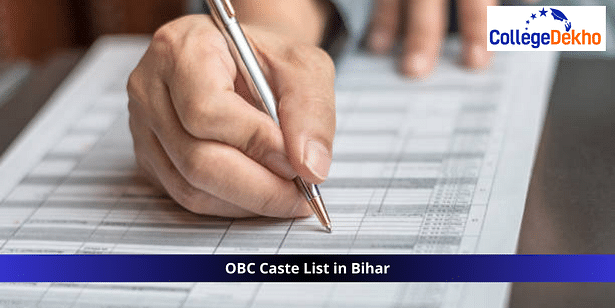The OBC Caste List in Bihar is mainly divided into two categories: Backward Class (BC) and Extremely Backward Class (EBC). The updated Bihar OBC Caste List is available on this page.

As per the Constitution of India, the Other Backward Classes or OBCs are categorized as socially and educationally backward classes (SEBC), and the Central Government is responsible for advancing these categories. As directed by the Indian Constitution, the Bihar OBC quota and reservation are at 27% in Higher Education and Government Sector jobs.
Bihar is one of the largest Indian states, with regard to its population and area. With a total population of 13 crores, as per the Bihar caste census 2025 update, there are over 200 different castes residing in the state. Approximately 33 castes in Bihar are categorised as OBC 1 (Other Backward Classes), and approximately 113 castes come under the category of Economically Backward Classes, Bihar (OBC 2).
After the OBC Caste List in Bihar, the Extremely Backward Classes make it to the list of the Backward Classes in Bihar, with overall 36% of the entire population. Both of these backward classes make up a total of 63% reservations.
In this article, students can find detailed information on the Bihar OBC list with benefits, updates, and changes in the OBC Bihar list, the difference between OBC, SC, CT, and EBS categories in Bihar.
Related Articles:
Updates and Changes for OBC Caste List in Bihar
As per the Bihar caste census 2025 update, the Bihar government has decided to raise the job reservation for marginalised people from 50% to 65%. With a rise in the 10% quota for economically backward classes Bihar, the overall Bihar OBC quota and reservation now stands at 75%. As per the updated Bihar OBC reservation percentage 2025, 63% is for Other Backward Classes. 20% is for SC, 2% for ST, and 43% for Backward and Extremely Backward Classes.
Students can check out the PDF attached below to learn more about the OBC Caste List in Bihar:
Related Articles:
Updated List for OBC Caste List in Bihar
As discussed, the OBCs have witnessed social and economic mobility. The following table represents a comprehensive OBC caste list in Bihar.
Abdal | Agariya | Aghori |
|---|---|---|
Amaat | Kasab (Kasai) (Muslim) | Kewat, Keot |
Kadar | Kaivartta/ Kaibartta | Kalandar |
Kaura | Kawar | Kochh |
Korku | Kumarbagh Pahadia | Kurmi |
Kurmi (Mahto) (in Chhotanagpur Division only) | Kagzi | Kanu |
Kamar (Lohar, Karmkar, Visvakarma) | Kushwaha (Koeri) | Kapadia |
Kosta, Koshta | Khatik | Khangar |
Khatwa, Khatwe, Khadwar (only in the districts of Sivan & Rohtas) | Khetauri, Khatauri | Khelta |
Godi (Chhava) | Gaddi | Gandarbh or Gandharb |
Gangai (Ganesh) | Gangota, Gangoth | Gorh, Gonrh (only in the districts of Saran & Rohtas) |
Barai | Gulgaliya | Goud |
Ghatwar | Chik (Muslim) | Chain |
Chayeen | Chapota | Chandrabanshi (Kahar) |
Churihar (Muslim) | Chanou | Jogi (Jugi) |
Tikulhar | Dafali (Muslim) | Dhekaru |
Tanti (Tatwa), Tati, Tatin | Turha | Tamariya |
Tiyar | Tamoli, Tamboli | Teli |
Tharu | Devhar | Dhanuk |
Dhobi (Muslim) | Dhunia (Muslim) | Dhamin |
Dhankar | Dhimar | Nai |
Nat (Muslim) | Nunia, Nonia | Namshudra |
Naiya | Nalband (Muslim) | Pamaria (Muslim) |
Prajapati (Kumhar) | Pandi | Pinganiya |
Parya | Pradhan | Pahira |
Pal (Bherihar-Gaderi) | Gaderia | Bekhada |
Bagdi | Bari | Beldar |
Bind | Barhai (Viswakarma) | Badhai |
Differences between OBC, EBC, SC, ST in Bihar
Here are some of the key differences among the percentage of seats reserved for OBC, EBC, SC, and ST categories in Bihar 2025:
Reserved Category | Description |
|---|---|
Scheduled Caste | 20% |
Scheduled Tribe | 2% |
Other Backward Class | 63% |
Economically Backward Class | 10% |
Importance of the OBC Caste List
In Bihar, according to a government poll, the majority of people live as EBCs, with 112 castes, accounting for 36.01% of the total population. The next largest group of people are OBCs, with 29 castes and a 27.12% share. Out of all the OBC castes, the Yadavs hold the largest percentage at 14.26%. The percentage of people who belong to Scheduled Castes is 19.65%, whilst the percentage of people who are not reserved is 15.52% of the total population.
OBCs, as opposed to even the higher castes, have the most rapid intergenerational mobility, based on a recent International Monetary Fund analysis. In contrast to the Dalits, they became landlords and landowners. As a result of the Mandal Commission's implementation in 1990, they were able to access formal economic possibilities, higher education, entry into the formal sector, etc.
Criteria for Inclusion in the OBC List
Before the Mandal Commission report's proposal of implementing a reservation policy in government positions and educational institutions, there was a significant discrepancy between different castes and groups designated as Other Backward Class. A portion of Other Backward Castes held a significant amount of land and hired Scheduled Castes (SC) as agricultural labourers, even though the majority of this group was exceedingly backward. Due to their substantial land holdings, the Kurmis, Yadavs, and Koeris — referred to as "upper-OBC" — were prosperous in several North Indian states. After India gained its freedom, the Zamindari system was abolished, which gave many of the people living in these villages the title of landlords.
Related Articles:
Benefits for OBC Communities
Considering the OBC caste list in Bihar comprised both Muslims and Hindus, the movement was commonly called a "secular upsurge" or the "second democratic upsurge". They were considered by some academics to be "bullock capitalists" because they were landowners but also socially regressive. Because of this, they were able to undermine the viability of left-wing class politics in India and enhance the centrist nature of Indian politics. Furthermore, because of their low caste status, they rejected the majoritarian confessional politics of the Right. Numerous initiatives and strategies are being carried out by the federal and state governments to improve the status of OBCs. The OBC caste list in Bihar benefits from several factors, including:
There is a 27% reservation quota for seats at government institutes like the IIMs and IITs, as well as posts like IPS, IAS, and so forth.
The maximum age limit for many exams, including the UPSC Civil Services Exam, has changed. On the other hand, there are fewer limitations on the number of test administrations. For cut-off marks, there is leniency.
Related Articles:
To avail of the benefits of the Bihar OBC caste list, students need to be aware of the complete beneficiaries provided by the Government of India. Since the state government has accepted a 10% quota for the EWS groups in the state, as per the directions given by the Central Government, the total quota for the OBC caste in Bihar now stands at 75%.
If you wish to know more about the OBC Caste List in Bihar, or have any queries that you want us to address, then you can write to us at our QnA Zone , or feel free to ring us up on our toll-free number 1800-572-9877. Fill out CollegeDekho’s Common Application Form to get in touch with our certified college counsellors!
Keep visiting CollegeDekho for the latest updates and notifications.
Are you feeling lost and unsure about what career path to take after completing 12th standard?
Say goodbye to confusion and hello to a bright future!

FAQs
As per reports, it is believed that the Bihar Government updates the OBC list every 10 years.
The main difference between the OBC and EBC categories is that the OBC (Other Backward Classes) is a social category that is based on caste, and the EBC (Economically Backward Classes) is based on the economic status of an individual in Bihar.
The Bihar OBC list with benefits includes educational scholarships and subsidies, hostel facilities, monetary assistance for skill development in state, etc.
To check whether a certain caste is included in the Bihar OBC list or not, students must visit the official website of the National Commission for Backward Classes (NCBC) or visit the nearest Block Development Office (BDO) to inquire about the same.
No, the EBC and the OBC caste list in Bihar are not the same. The term "Economically Backward Classes" (EBC) refers to a grouping of individuals whose household income is less than INR 8 LPA. However, the OBC, ST, or SC schedules of scheduled castes do not apply to this group of people.
No, the Indian government has not made any recent additions to the OBC caste list in Bihar. As of 2024, a total of 133 OBC caste/community people reside in Bihar. Every year, the Bihar government carries out a caste census to introduce new schemes for the benefit of people.
The importance of the OBC caste list in Bihar is for people to understand their collective population and the rights offered by the Indian government. With this, they can take advantage of the educational schemes and other beneficiaries.
The OBC population of Bihar is 63% overall. Following the Other Backward Classes, who make up 27.13% of the population, the Extremely Backward Classes make up the largest social category in Bihar, with 36% of the overall population.
The OBC caste list in Bihar includes Chayeen, Chapota, Pandi, Pinganiya, Pradhan, Pahira, Abdal, Amaat, Kadar, Kaura, Korku, Kaivartta/ Kaibartta, Kalandar, Kawar, Kochh, Kumarbagh, Pahadia, Kurmi, Kagzi, Kanu, and more.
Was this article helpful?





















Similar Articles
27th WB SET SC Category Expected Cutoff 2025 for All Subjects
27th WB SET Bengali Cutoff 2025: Check expected cutoff, previous years' cutoffs
27th WB SET General Category Expected Cutoff 2025 for All Subjects
27th WB SET English Cutoff 2025: Check expected cutoff, previous years' cutoff trends
115 Marks in AP TET vs AP DSC Weightage Analysis 2025
SHRESHTA Class 11 Schools List 2026 State-Wise